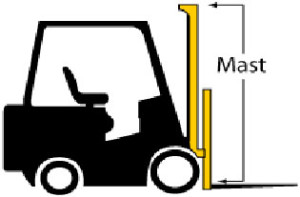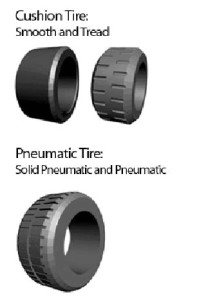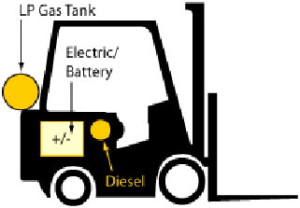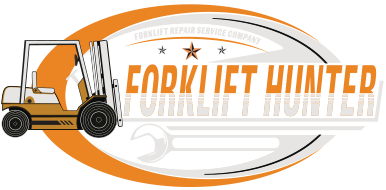Buying A Forklift 101
Buying a Forklift – Forklifts For Sale
Forklift 101:
Forklift Hunter has put together a list of recommendations of Buying A Forklift 101 that all customers should review and check off before purchasing a forklift from any dealer with schematic examples of each bullet point in the right hand column. After reading over the list, please visit our Forklifts For Sale section to see many models fully equipped to meet your company’s needs.
Forklift Mast:
 Size does matter. When selecting a forklift, always make sure the mast height does not exceed the height of the lowest door clearance of your facility.
Size does matter. When selecting a forklift, always make sure the mast height does not exceed the height of the lowest door clearance of your facility.
In addition, be sure to take into consideration the reach/extension of the lift to be sure it meets your needs. If you are operating inside a box trailer or truck you will need a free lift mast.
 Forklift Tires:
Forklift Tires:
– Cushion Tires
Solid rubber compound press-on tire. Available with a tread design or smooth. Also available in a white non-marking rubber compound.
– Solid Pneumatic Tires
For use on dirt and gravel surfaces, or for “soft yard” applications. Solid Pneumatic tires do not hold air, therefore, they are good for construction or job sites where there are a lot of sharp objects, otherwise known as “flat hazards.”
– Pneumatic Tires
Pneumatic tires are also used on dirt and gravel surfaces and soft yards. They provide slightly better traction than Solid Pneumatic tires, but they are susceptible to flats because they hold air. They are also about half the cost of solid pneumatic tires and offer a smother ride.
 Forklift Fuel:
Forklift Fuel:
There are four fuel options to consider when purchasing a forklift.
– Diesel
Provides the most torque and power for outdoor construction and job site applications. Most diesel powered forklifts will be equipped with pneumatic tires.
– L.P. Gas
For use outdoors and indoors. Most Cushion Tire forklifts are powered with L.P. Gas. Because L.P. Gas forklifts produce lower emissions, they can be used in some indoor applications.
– Gasoline
Although gasoline is rarely used as fuel for forklifts, gas-powered models are available but can only be used outdoors due to the high amount of emissions.
– Electric
For use mainly indoors on smooth, hard surfaces. Electric forklifts may be used outdoors when conditions are dry but are never to be used in a wet environment. They are perfect for indoor warehouse use because they do not produce exhaust and are quiet during operation.
 Forklift Forks:
Forklift Forks:
Know your usage.
42″ forks are most commonly used for standard 48″ pallets. Forks should be slightly shorter than the pallet being moved because forks that stick out through the other side of the pallet being carried can cause damage to other shelved products. Longer forks will decrease a forklift’s overall turning radius, so always choose the shortest forks possible for the job.
Forklift Attachments:
Consider attachments that may benefit your operation: side-shifter (moves forks right or left); Fork positioner (re-position forks to adjust to a wider pallet or object); Clamps of various types to handle numerous different objects (i.e. paper rolls, tires, cartons, etc)
Forklift Hours:
Hours on a forklift are the equivalent of miles on a car’s odometer. The more hours the forklift is used, the more wear and tear on its engine, transmission, and other moving parts. Some brands and types will give you a breakdown of the hours (e.g. key on hours, drive motor hours, etc.).
Here you can create the content that will be used within the module.
